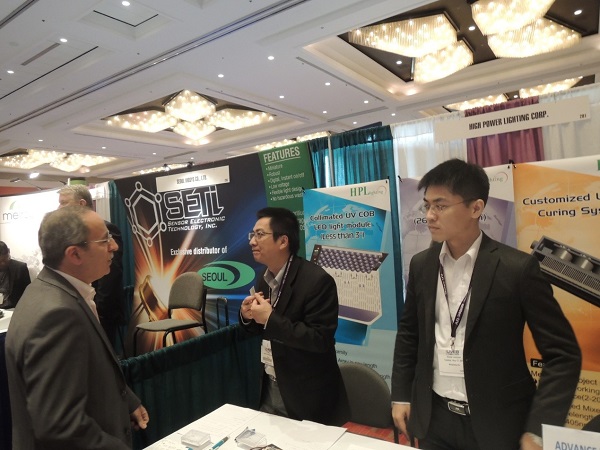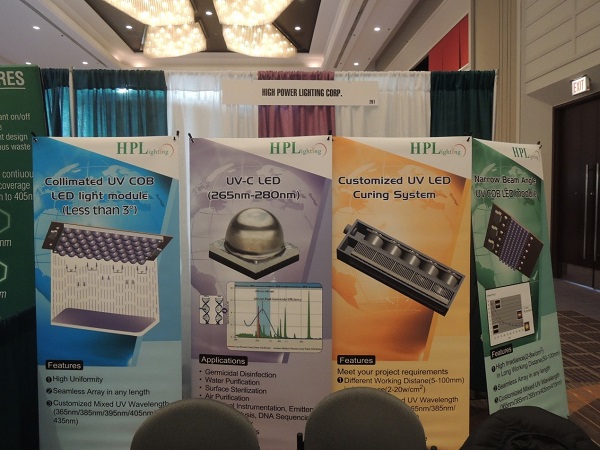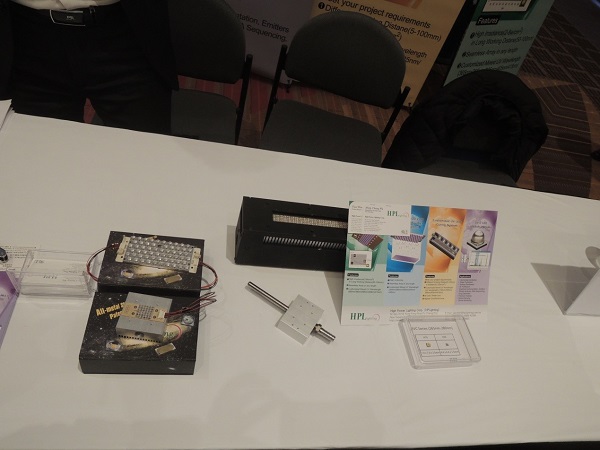Many manufacturers displayed advanced UV LED curing and disinfection technologies at RadTech UV 2016, which recently took place from May 16-18 in Chicago, U.S. The leading UV technology show integrates forums and exhibitions, and is an important indicator in the sector. Dr. Ming-chang Wu, Vice President of High Power Lighting Group (HPL) spoke to LEDinside about the company’s UV LED product trends and solutions.
HPL was established in 2005 and up to 2014 was advancing its UV LED technology, for instance improving UV LED intensity, package material, and improving compatibility. The company was one of the pioneers in the industry to develop UV LED optics and system designs. Following technology and market developments, the company started to shift its emphasis to optimizing optic designs to achieve uniform collimated lighting effects in different application market sectors in 2015. The company’s four highlighted UV LED products in 2016 are mainly for PCB exposurers, oil-based printing, UV-C LED and many other applications. HPL has become a main supplier of UV LED products.
 |
 |
|
Top: Visitors gathering at High Power Lighting Group's (HPL) booth. Bottom: HPL's products. |
HPL’s Customized UV COB LED Module
For high-speed printing applications and LCD glass bonding machines for smartphones, HPL has introduced UV COB LED modules on copper substrates and with quartz glass optic designs. The module UV LEDs have a wavelength between 365 nm-415 nm, and based on client wattage demands the modules are seamlessly connected. At a working distance of 50 mm-100 mm, a single module’s irradiance can reach 2-8 W/ cm2.
Solving UV LED uniform parallel light issues with less than 3° optical system
It has always been challenging to use UV LEDs in exposurers, mainly caused by the difficulty in achieving uniform parallel light in the optic design. In comparison, traditional mercury lights can emit parallel light as the light travels through the twisted glass tube. If UV LEDs used a similar design, it would lose a lot of light emitted. To solve this issue, HPL’s UV LED optic design uses a special secondary optic design to achieve parallel light of less than 2°, and a more uniform light emission, making it suitable for PCB, LCD and IC exposurer applications. Moreover, the product emphasizes introducing the LEDs into new equipment applications, and has successfully been introduced by a Taiwanese equipment manufacturer, who has sent samples of the UV LED equipment to Japanese clients. In the future, HPL will continue to strengthen its stray light processing to ensure the light emitted is uniform and concentrated.
Pressurized water cooling systems boosts thermal dissipation issues
After accumulating many years of experience in optic designs, and receiving advice from clients, the company started to develop a water cooling system. Current water cooling systems tend to have temperature equalization and heat exchange efficiency issues, which have existed in cooling systems for many years. HPL is using water pressure methods to direct water into the interior tubes, the cool water is steadily injected through holes in the water pressure device and flows into the hot water area to equalize the temperature and take away the heat source to raise overall curing efficiency.
UV-C LED products for disinfection holds large market potential
HPL is optimistic about UV-C market outlook, especially for air purifiers, water purification, food preservation and medical disinfection applications. These applications all present huge market opportunities, and have increased UV-C LED package products inquiries on the market. The company currently uses international manufacturers LED chips, and is considering using Taiwanese LED suppliers products. The company’s package products have overcome difficulties in UV-C LED packaging, and possesses comprehensive plating on glass technology, and product reliability that can withstand market tests.
HPL has become a leading UV LED brand in the Greater China region, due to its advanced LED package technology, copper substrate and quartz optic designs. At the same time the company is promoting its comprehensive patented solution worldwide in 2016.
 |
|
HPL's products. |
LEDinside analyses: UV-C LED applications mainly can be used in four applications including air purification, water purification, food preservation, and surpress germ growth. The medical market presents great market potential, but the products need to be approved by the Food and Drug Administration in U.S.
If UV LED can make breakthroughs in energy consumption, lifetime, and lower costs, it could spur UVC LED market demands.
















